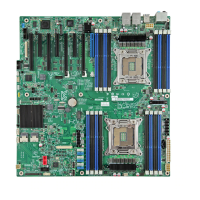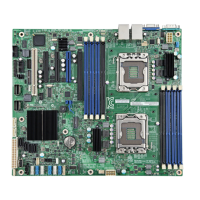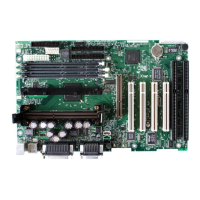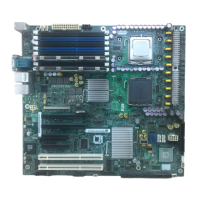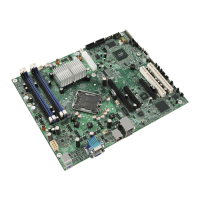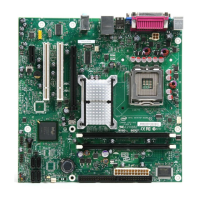Appendix A: Integration and Usage Tips Intel® Server Board S2400SC TPS
Intel order number G36516-002 Revision 2.0
Appendix A: Integration and Usage Tips
When adding or removing components or peripherals from the server board, you must
remove AC power cord. With AC power plugged into the server board, 5-V standby is
still present even though the server board is powered off.
This server board supports Intel
®
Xeon
®
Processor E5-2400 product family or Intel
®
Xeon
®
Processor E5-2400 v2 product family with a Thermal Design Power (TDP) of up
to and including 95 Watts. Previous generation Intel
®
Xeon
®
processors are not
supported.
You must install processors in order. CPU 1 is located near the back edge of the server
board and must be populated to operate the board.
The PCIe slot 3 does NOT support the Intel
®
PCIe gen3 ROC modules.
The onboard SATA connectors 0 and 1 are designed to support the ODD or SSD, do
NOT connect SATA connector 0 and 1 to the backplane. The onboard SATA connectors
2-5 are designed to support the backplane.
On the back edge of the server board are EIGHT diagnostic LEDs that display a
sequence of amber POST codes during the boot process. If the server board hangs
during POST, the LEDs display the last POST event run before the hang.
Only Registered DDR3 DIMMs (RDIMMs) and Unbuffered DDR3 DIMMs (UDIMMs) are
supported on this server board. Mixing of RDIMMs and UDIMMs is not supported.
For the best performance, you should balance the number of DDR3 DIMMs installed
across both processor sockets and memory channels. For example: a Two-DIMM
configuration performs better than a One-DIMM configuration. In a Two-DIMM
configuration, you should install DIMMs in DIMM sockets A1 and D1. A Six-DIMM
configuration (DIMM Sockets A1, B1, C1, D1, E1, and F1) performs better than a Three-
DIMM configuration (DIMM Sockets A1, B1, and C1).
The Intel
®
RMM4/RMM4 Lite connectors are not compatible with the previous Intel
®
Remote Management Modules
Clear CMOS with the AC power cord plugged in. Removing AC power before performing
the CMOS Clear operation causes the system to automatically power up and
immediately power down after the CMOS Clear procedure is followed and AC power is
re-applied. If this happens, remove the AC power cord, wait 30 seconds, and then re-
connect the AC power cord. Power up the system and proceed to the <F2> BIOS Setup
Utility to reset the desired settings.
Normal BMC functionality is disabled with the Force BMC Update jumper (J1C4) set to
the “enabled” position (pins 2-3). You should never run the server with the Force BMC
Update jumper set in this position and should only use the jumper in this position when
the standard firmware update process fails. This jumper must remain in the default
(disabled) position (pins 1-2) when the server is running normally.
This server board no longer supports the Rolling BIOS (two BIOS banks). It implements
the BIOS Recovery mechanism instead.
When performing a normal BIOS update procedure, you must set the BIOS Recovery
jumper (J1C5) to its default position (pins 1-2).
